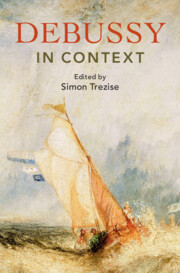Book contents
- Debussy in Context
- Composers in Context
- Debussy in Context
- Copyright page
- Dedication
- Contents
- Illustrations
- Contributors
- Preface
- Notes on the Text
- Abbreviations
- Part I Paris: City, Politics, and Society
- Part II The Arts
- Part III People and Milieu
- Part IV Musical Life: Infrastructure and Earning a Living
- Chapter 18 The Jobbing Composer-Musician
- Chapter 19 Parisian Opera Institutions: A Framework for Creation
- Chapter 20 Société Nationale and Other Institutions
- Chapter 21 Debussy Noctambule and Parisian Popular Culture
- Chapter 22 Music Criticism and Related Writing in Paris
- Part V The Music of Debussy’s Time
- Part VI Performers, Reception, and Posterity
- Recommendations for Further Reading and Research
- Index
Chapter 20 - Société Nationale and Other Institutions
from Part IV - Musical Life: Infrastructure and Earning a Living
Published online by Cambridge University Press: 23 May 2024
- Debussy in Context
- Composers in Context
- Debussy in Context
- Copyright page
- Dedication
- Contents
- Illustrations
- Contributors
- Preface
- Notes on the Text
- Abbreviations
- Part I Paris: City, Politics, and Society
- Part II The Arts
- Part III People and Milieu
- Part IV Musical Life: Infrastructure and Earning a Living
- Chapter 18 The Jobbing Composer-Musician
- Chapter 19 Parisian Opera Institutions: A Framework for Creation
- Chapter 20 Société Nationale and Other Institutions
- Chapter 21 Debussy Noctambule and Parisian Popular Culture
- Chapter 22 Music Criticism and Related Writing in Paris
- Part V The Music of Debussy’s Time
- Part VI Performers, Reception, and Posterity
- Recommendations for Further Reading and Research
- Index
Summary
In the years around 1900, Paris was home to three major, well-established orchestras, each of which had its loyal patrons. While there were some differences in programming philosophy, concerts of all three ensembles generally featured an eclectic mix of music of different genres and from different eras. The abundance of concert music would have astonished listeners from the years before the Franco-Prussian War, when there was relatively little interest in non-theatrical music, and even less in such music by French composers. This situation changed after L’année terrible, which resulted in much national soul-searching in France and led to a new mood of sobriety. Musically, this was manifested in increased interest in orchestral and chamber music. The Société nationale de musique was founded in 1871 to encourage the production of such ‘pure’ music by French composers. Over the next several decades, it offered a venue where composers could present their latest creations before a select and appreciative audience. Debussy was an active member of the SN after 1888 and some of his most significant works were introduced at its concerts. But because its concerts were generally open only to members and invited guests, the SN had very little impact on public taste. Most new French orchestral music was premiered not at SN concerts, but at those of the orchestral concerts led by Jules Pasedeloup, Édouard Colonne, and Charles Lamoureux, all of whom performed a great deal of music by French composers in the years after the Franco-Prussian War. By the 1890s, however, growing public interest in Wagner’s music and the popularity of music by an earlier generation of French composers let to decreased opportunities for younger French composers. Debussy proved to be a rare exception and, especially after the success of Pelléas et Mélisande in 1902, his music appeared frequently on the concerts of all the Parisian orchestral societies.
- Type
- Chapter
- Information
- Debussy in Context , pp. 185 - 192Publisher: Cambridge University PressPrint publication year: 2024



